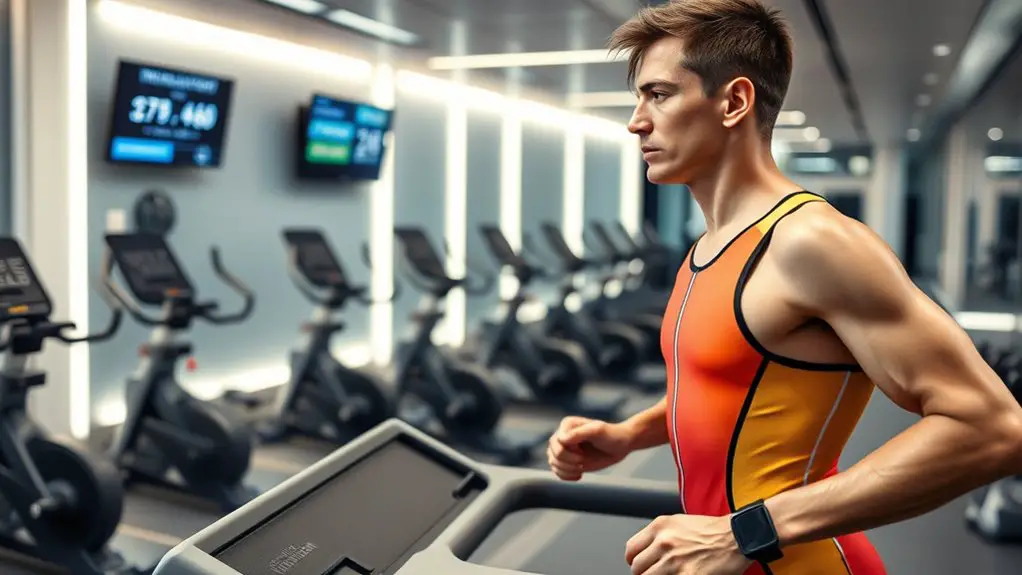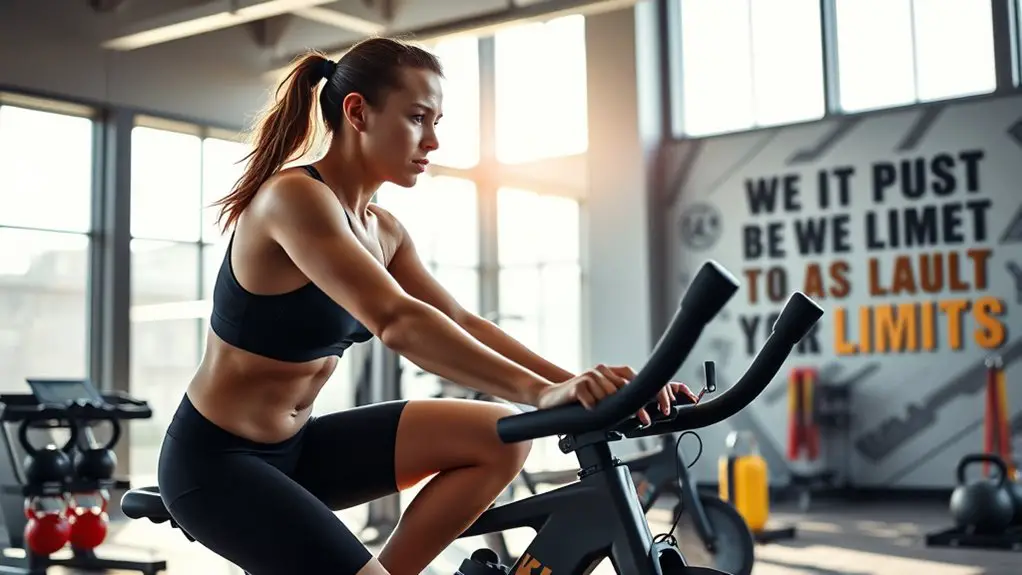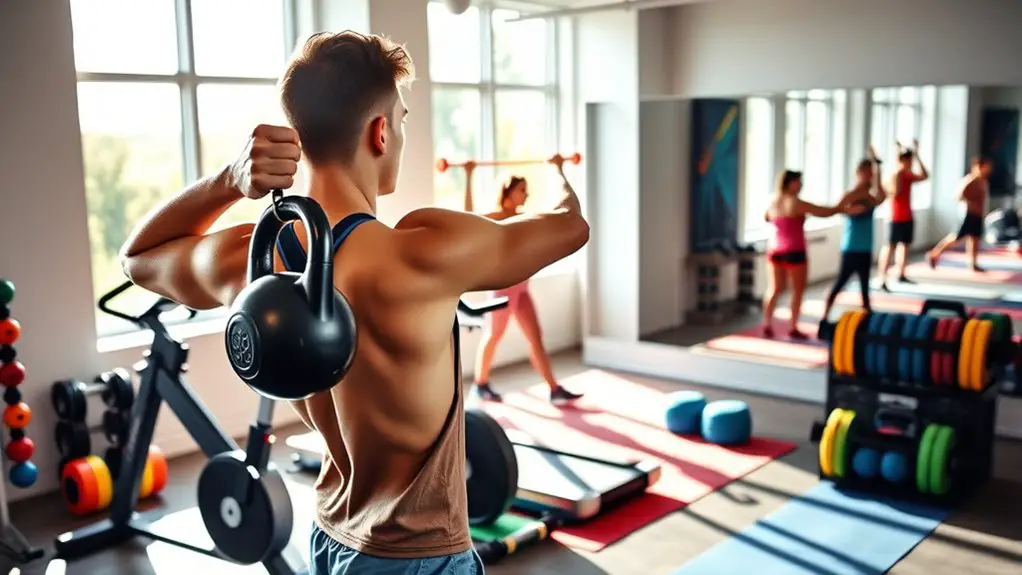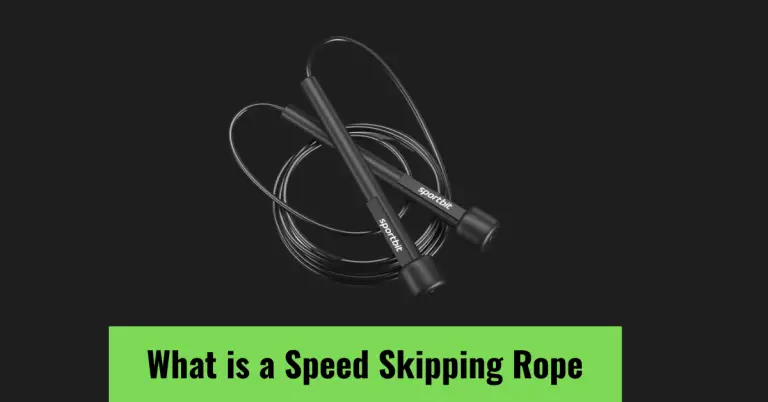How to Train for a Triathlon Using Gym Equipment

To train for a triathlon using gym equipment, focus on building endurance and strength in each discipline. Use the treadmill for your running sessions to improve speed and stamina. For cycling, incorporate stationary bikes to boost leg strength. Enhance swim training with aquatic equipment like kickboards and paddles. Don’t forget to monitor your progress with fitness trackers to guarantee you’re on track. There’s much more you can learn to maximize your training effectiveness.
Understanding the Triathlon Distances

When you’re gearing up for a triathlon, understanding the different distances is essential. Triathlon formats vary widely, from sprint distances to the grueling Ironman. Familiarizing yourself with these distance breakdowns helps you choose the right race for your fitness level and goals.
For instance, a sprint triathlon typically includes a 750m swim, a 20km bike ride, and a 5km run. If you’re feeling more ambitious, the Olympic distance increases to a 1.5km swim, a 40km bike ride, and a 10km run.
Half Ironman distances are even more challenging, featuring a 1.9km swim, a 90km bike ride, and a 21.1km run. Finally, the full Ironman covers a formidable 3.8km swim, 180km bike ride, and 42.2km run. Knowing these distances equips you to train safely and effectively, ensuring you’re prepared for the demands of your chosen event.
Importance of a Structured Training Plan
A structured training plan is essential for your triathlon success, as it helps you set clear goals and track your progress effectively. By balancing different workout components, you’ll guarantee that you’re well-prepared for each leg of the race. Let’s explore how to create a plan that keeps you motivated and on track.
Goal Setting Strategies
Establishing clear goals is essential for your triathlon training, as it provides direction and motivation throughout your journey. Using the SMART goals framework helps you set specific, measurable, achievable, relevant, and time-bound targets. Start with a long-term vision, then break it down into short-term milestones to keep you on track. Here are some motivation techniques to contemplate:
| Motivation Technique | Description |
|---|---|
| Visualize Success | Imagine crossing the finish line. |
| Reward Yourself | Treat yourself after reaching milestones. |
| Join a Community | Connect with fellow triathletes for support. |
| Track Progress | Document your achievements regularly. |
| Set Challenges | Push yourself with new goals. |
These strategies will enhance your training experience and keep you safe while you progress towards your triathlon goals.
Tracking Progress Effectively
Tracking your progress effectively is crucial for staying on course during triathlon training, especially if you want to see tangible improvements. By establishing clear progress indicators, you can monitor your performance in swimming, cycling, and running. Use gym equipment to gather data, like heart rate and distance, which can be logged in a training diary or app. Data visualization tools can help you see trends, making it easier to identify areas needing attention. This structured approach not only keeps you motivated but also guarantees your training is safe and effective. Regularly reviewing your progress will help you make informed adjustments to your routine, ultimately leading to a stronger, more prepared you come race day.
Balancing Workout Components
Monitoring your progress sets the foundation for what comes next: balancing the different components of your training. It’s essential to create a structured plan that incorporates both cardio and strength training. Balancing these elements helps prevent injuries while enhancing your overall performance. Aim for two to three days of cardio workouts, such as cycling or running, focusing on building endurance. On alternate days, prioritize strength training to build muscle and improve your stability. Don’t forget to include rest days for recovery, as your body needs time to adapt and grow stronger. By keeping this balance, you’ll guarantee that you’re well-prepared for the challenges of a triathlon while maintaining your safety and well-being throughout the process.
Utilizing the Treadmill for Running Endurance
While you might prefer the open road, utilizing the treadmill for running endurance can be a game-changer in your triathlon training. It allows you to control your environment and focus on specific workouts, like treadmill intervals and incline training, which can enhance your performance safely.
Consider these benefits for your treadmill sessions:
- Controlled Environment: No weather concerns, so you can train consistently.
- Variable Speeds: Adjust your pace for different workout types, including sprints and recovery runs.
- Incline Options: Simulate hill training to build strength and endurance safely.
- Heart Rate Monitoring: Easily track your heart rate to stay within safe training zones.
- Reduced Impact: Softer surfaces can minimize joint stress compared to hard pavement.
Incorporating these elements into your routine will help you build the endurance you need for race day while keeping your training safe and effective.
Incorporating Stationary Bikes for Cycling Strength

After building your running endurance on the treadmill, it’s time to focus on cycling strength with stationary bikes. These bikes offer numerous benefits, like low-impact workouts that reduce stress on your joints while still providing an effective cardio session. To maximize your training, incorporate cycling intervals into your routine.
Start with a warm-up, then alternate between high-intensity bursts and moderate-paced cycling. For example, pedal hard for 30 seconds, followed by one minute of easy cycling. This method not only boosts your strength but also improves your aerobic capacity.
Always maintain proper posture while riding, keeping your back straight and hands relaxed on the handlebars. Adjust the seat height to guarantee comfort and prevent injury. Remember, safety’s key, so listen to your body and avoid pushing yourself too hard, especially when trying new intensity levels. With these practices, you’ll build cycling strength effectively for your triathlon.
Enhancing Swim Training With Aquatic Equipment
When it comes to swim training, using aquatic equipment can really boost your performance. Resistance bands help build strength, while swim paddles enhance your stroke technique. Don’t forget about kickboards, which are great for focusing on your form and kicking power.
Resistance Bands Benefits
Using resistance bands can greatly enhance your swim training, as they provide an innovative way to build strength and improve technique. These bands are versatile and can be used for various resistance band exercises tailored to your needs. Plus, they’re safe to use when you follow proper form. Here are some benefits you’ll experience:
- Increased upper body strength for better strokes
- Improved core stability for a stronger kick
- Enhanced flexibility and range of motion
- Low-impact resistance band variations to prevent injury
- Convenient and portable for training anywhere
Incorporating resistance bands into your routine not only boosts your swim performance but also helps you train safely, allowing you to focus on your triathlon goals with confidence.
Swim Paddles Usage
Swim paddles can be a game-changer for your swim training, providing a unique way to enhance your technique and build strength. By incorporating swim paddle techniques into your workouts, you can effectively target your upper body muscles, promoting better endurance and power. Start with a lighter paddle to guarantee you maintain control and avoid strain. As you progress, you can gradually increase the size for more resistance. Focus on improving stroke efficiency by maintaining a strong, steady pull through the water. Remember to pay attention to your form, as improper technique can lead to injury. Always listen to your body, and take breaks as needed. With consistent practice, swim paddles can greatly elevate your triathlon training experience.
Kickboards for Technique
Although kickboards might seem simple, they play an essential role in enhancing your swim technique during triathlon training. Incorporating kickboard drills into your routine can help you focus on specific aspects of your stroke, ensuring you swim efficiently and safely. Here’s how kickboards can benefit you:
- Isolate your legs to strengthen your kick
- Improve body position and buoyancy in the water
- Enhance your breathing technique while swimming
- Develop endurance without straining your arms
- Refine your overall swim technique for better performance
When using kickboards, always pay attention to your form and avoid overexertion. These drills can greatly elevate your swim skills, making you more confident in the water during your triathlon. Happy training!
Building Core Strength With Resistance Machines
Building core strength is essential for triathletes, as it enhances stability and boosts overall performance. Using resistance machines for core stability exercises can be both effective and safe. Here’s a quick guide to help you get started with machine-based workouts focused on your core.
| Exercise | Machine Used | Repetitions/Set |
|---|---|---|
| Seated Ab Crunch | Abdominal Crunch | 10-15 |
| Back Extension | Hyperextension Bench | 10-15 |
| Cable Woodchoppers | Cable Machine | 8-12 (each side) |
| Leg Raises | Captain’s Chair | 10-15 |
| Plank Machine | Plank Machine | 30 seconds |
Incorporate these exercises into your routine, ensuring proper form to avoid injury. Remember, proper technique is crucial to minimize injury risk while enhancing your core stability. Start with lighter weights and gradually increase as you build strength. Your core will thank you!
Cross-Training Benefits and Techniques

A strong core sets the foundation for effective cross-training, which can greatly enhance your triathlon performance. By incorporating safe cross-training techniques, you can improve strength, endurance, and flexibility while minimizing the risk of injury. Here are some benefits of cross-training:
- Increased overall strength for better power output
- Enhanced cardiovascular fitness without excessive strain
- Improved flexibility and range of motion
- Reduced chances of overuse injuries
- Greater mental motivation and variety in workouts
Utilizing gym equipment for cross-training helps target different muscle groups, keeping your training balanced and effective. Focus on low-impact exercises like cycling and swimming, which can aid in injury prevention while still challenging your body. Always listen to your body, and adjust your routines to stay safe and effective. By integrating cross-training into your regimen, you’ll build a solid foundation for your triathlon goals. Additionally, incorporating activities like skipping rope can provide both aerobic and anaerobic benefits, further enhancing your fitness routine.
Monitoring Progress With Fitness Trackers
When you’re training for a triathlon, choosing the right fitness tracker can make a big difference in your progress. You’ll want to track your workouts effectively and analyze key performance metrics to see how you’re improving. Let’s explore how to select a tracker that suits your needs and use it to maximize your training.
Choosing the Right Tracker
How can you keep track of your progress effectively while training for a triathlon? Choosing the right tracker is essential for monitoring your fitness goals. Look for a device that offers features tailored to your needs, ensuring you stay safe and informed. Consider these important aspects:
- Heart rate monitoring for safe training intensity
- GPS tracking for accurate distance measurement
- Water resistance for swimming sessions
- Activity tracking for all three disciplines
- Smartphone compatibility for easy data access
Tracking Workouts Effectively
To effectively track your workouts during triathlon training, leveraging the capabilities of fitness trackers is essential. These devices can monitor your heart rate, calories burned, and workout duration, ensuring you’re training safely and effectively. Pair your tracker with fitness apps that allow you to log your progress and set achievable goals. You can also maintain a workout journal to jot down your feelings after each session, helping you identify what works best for your body. This combination of technology and personal reflection can enhance your training regimen, keeping you motivated and aware of your limits. Remember, consistent tracking not only boosts performance but also helps prevent injuries, ensuring you stay on track for your triathlon.
Analyzing Performance Metrics
What metrics should you be focusing on to truly understand your progress in triathlon training? Utilizing fitness trackers for performance analysis can greatly enhance your data interpretation. By monitoring specific metrics, you can identify areas that need improvement while guaranteeing your safety during workouts. Here are key metrics to track:
- Heart Rate: Guarantees you’re training in the right intensity zones.
- Distance Covered: Helps gauge endurance improvements.
- Pace: Assesses your speed and efficiency over time.
- Calories Burned: Provides insight into energy expenditure.
- Recovery Time: Monitors how quickly you bounce back post-workout.
Recovery Strategies Using Gym Facilities
While you may be keen to push through your training, incorporating effective recovery strategies using gym facilities is essential for maximizing your performance. To guarantee your body heals and performs at its best, consider integrating various recovery methods. Start with gym stretching, which helps maintain flexibility and reduces muscle tightness. Focus on dynamic stretches post-workout to promote circulation and static stretches for cooldowns.
Additionally, utilize foam rollers and massage chairs available at your gym to alleviate muscle soreness and improve blood flow. Don’t forget the benefits of hydration—take advantage of water stations to stay well-hydrated. If your gym offers a sauna or steam room, these can also aid in relaxation and recovery. Regularly cleaning your gym bag not only promotes better hygiene but also enhances your overall recovery experience. Remember, prioritizing recovery not only enhances your training but also minimizes the risk of injury. Listen to your body, and give it the care it needs to perform effectively during your triathlon.
Simulating Race Conditions in the Gym
After incorporating effective recovery strategies, you’re ready to focus on simulating race conditions in the gym. This will prepare you for the real thing while prioritizing safety. You can create a thorough race simulation by combining various workouts. Here are some effective strategies:
- Use treadmill intervals to boost your running speed and stamina.
- Incorporate cycling drills to enhance your leg strength and endurance.
- Schedule swim workouts with a focus on technique and pacing strategies.
- Add strength circuits to build overall body strength, essential for triathlons.
- Practice shifts between disciplines to improve efficiency and minimize downtime.
These endurance challenges will help you adapt to race conditions while ensuring you stay safe. By consistently integrating these elements, you’ll not only simulate race day but also sharpen your overall performance for a successful triathlon.
Frequently Asked Questions
Can I Train for a Triathlon Without Gym Equipment?
Yes, you can train for a triathlon without gym equipment! Focus on outdoor training by running or cycling in your local area. Incorporate swim drills in a safe, supervised pool or open water setting. Make sure you’re aware of your surroundings and prioritize safety. You don’t need a gym to build endurance and strength; just be creative with your workouts, using bodyweight exercises and natural terrain to enhance your training.
How Often Should I Cross-Train for Triathlon Preparation?
To maximize your triathlon preparation, aim for cross training at least two to three times a week. This ideal schedule helps improve your overall fitness while reducing the risk of injury. Incorporating activities like swimming, cycling, or strength training offers cross training benefits, enhancing your endurance and muscle balance. Remember to listen to your body and allow for rest days, ensuring you stay safe and energized throughout your training journey.
What Nutrition Should I Focus on During Training?
When you’re training hard, your nutrition can make or break your performance. You might wonder, what should you focus on? Start with your carbohydrate intake; it fuels your workouts and aids recovery. But don’t forget about protein timing—consuming protein post-workout helps muscle repair and growth. Balancing these nutrients is essential for avoiding injuries and keeping your energy up. So, make every meal count; your body will thank you during those intense training sessions!
How Do I Prevent Injuries While Training?
To prevent injuries while training, you should focus on injury prevention techniques. Always incorporate proper stretching before and after your workouts to enhance flexibility and reduce muscle tightness. It’s crucial to listen to your body; if something hurts, don’t push through the pain. Gradually increase your workout intensity and make certain you’re using the correct form during exercises. Finally, give yourself adequate rest days to allow your body to recover and stay safe.
What Is the Best Recovery Time Between Workouts?
Finding the right recovery time between workouts is vital for your safety and performance. You should incorporate active recovery days, where you engage in light activities like walking or stretching, to promote circulation without overexerting yourself. Additionally, don’t underestimate the power of rest days; they’re fundamental for your muscles to repair and grow. Balancing both will help you stay injury-free and ready for your next session, ensuring you progress safely and effectively.





